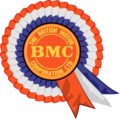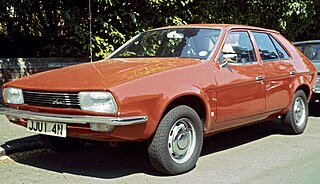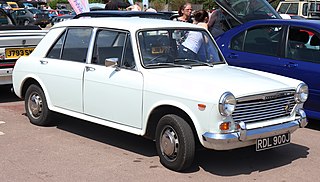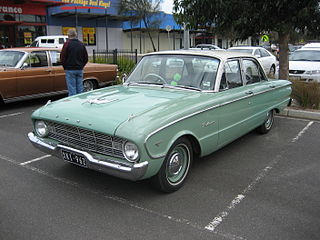
The British Motor Corporation Limited (BMC) was a UK-based vehicle manufacturer, formed in early 1952 to give effect to an agreed merger of the Morris and Austin businesses.

The Princess is a large family car which was produced in the United Kingdom by the Austin-Morris division of British Leyland from 1975 until 1981. The car inherited a front-wheel drive / transverse engine configuration from its predecessor, the Austin/Morris 1800 range. This was still unusual in Europe for family cars of this type and gave the Princess a cabin space advantage when compared with similarly sized cars from competing manufacturers.

The Ford Falcon is a full-sized car that was manufactured by Ford Australia from 1960 to 2016. From the XA series of 1972 onward, each Falcon and range of derivates have been designed, developed, and built in Australia, following the phasing out of the American-influenced Falcon of 1960 to 1971, which had been re-engineered locally as the XK to XY series for the harsher Australian conditions. The luxury-oriented Ford Fairmont model joined the range from 1965. Luxury long-wheelbase derivative versions called the Ford Fairlane and LTD arrived in 1967 and 1973, respectively.

The Leyland P76 is a large car that was produced by Leyland Australia, the Australian subsidiary of British Leyland. Featuring what was described at the time as the "standard Australian wheelbase of 111 inches", it was intended to provide the company with a genuine rival to large local models like the Ford Falcon, the Holden Kingswood, and the Chrysler Valiant. But, due to the first real fuel crisis and demand far exceeding the supply, Leyland rushed the assembly process with the first of the P76s to come off the assembly line, resulting in poor build quality and some reliability problems. The combination of the rushed assembly, fuel crisis and strikes at the component manufacturers' factories, resulted in the Leyland P76 being labelled a lemon, despite receiving the Wheels magazine Car of the Year in 1973. By 1974, sales of the P76 had slumped and BMC decided to end the production of the P76. Although the P76 has been labelled a lemon in Australian motoring history, it is viewed by some as an iconic Australian car and has a loyal following.

The Holden Torana is a mid-sized car that was manufactured by Holden from 1967 to 1980. The name comes from an Aboriginal word meaning "to fly". The original HB series Torana was released in 1967 and was a four-cylinder compact vehicle closely based on the British Vauxhall Viva HB series of 1966 - 1970.

The Nissan Bluebird is a compact car with a model name introduced in 1957. It has been Nissan's most internationally recognized sedan, in multiple body styles, and is known for its dependability and durability. The Bluebird originated from Nissan's first vehicles, dating to the early 1900s, and its traditional competitor became the Toyota Corona. The Bluebird was positioned to compete with the Corona, as the Corona was developed to continue offering a sedan used as a taxi since Toyota Crown was growing in size. Every generation of the Bluebird has been available as a taxi, duties that are shared with base level Nissan Cedrics. It is one of the longest-running nameplates from a Japanese automaker. It spawned most of Nissan's products sold internationally, and has been known by a number of different names and bodystyles, including the 160J/710/Violet/Auster/Stanza line.

BMC ADO17 is the model code used by the British Motor Corporation (BMC) for a range of large family cars manufactured from September 1964 to 1975. The car was initially sold under the Austin marque as the Austin 1800, then by Morris as the Morris 1800, by Wolseley as the Wolseley 18/85, and later the Austin 2200, Morris 2200 and Wolseley Six. The 1800 was voted European Car of the Year for 1965.

The BMC ADO16 is a range of small family cars built by the British Motor Corporation (BMC) and, later, British Leyland. Launched in 1962, it was Britain's best-selling car from 1963 to 1966 and from 1968 to 1971. The ADO16 was marketed under various make and model names; however, the Austin 1100 and Morris 1100 were the most prolific of all the ADO16 variants.

The BMC B series was a line of straight-4 & straight-6 internal combustion engine mostly used in motor cars, created by British company Austin Motor Company.

Wolseley Motors Limited was a British motor vehicle manufacturer founded in early 1901 by the Vickers armaments combine in conjunction with Herbert Austin. It initially made a full range, topped by large luxury cars, and dominated the market in the Edwardian era. The Vickers brothers died and, without their guidance, Wolseley expanded rapidly after the war, manufacturing 12,000 cars in 1921, and remained the biggest motor manufacturer in Britain.

The Wolseley 15/60 is an automobile which was produced from 1958 to 1961, and then, as the Wolseley 16/60, from 1961 to 1971. The 15/60 was the first of the mid-sized Pininfarina-styled automobiles manufactured by the British Motor Corporation (BMC). Launched in December 1958 as part of BMC's Wolseley brand, the design would eventually be shared with seven other marques. All of the cars were updated in 1961 with a larger engine and new model designations. The Wolseley 16/60 was the last, in production until 24 April 1971.

The Wolseley 24/80 is an automobile produced by British Motor Corporation (Australia) from May 1962 to October 1965, based on the British four-cylinder Wolseley 15/60 model.

The BMC E-series engine was a line of straight-4 and straight-6 overhead camshaft automobile petrol engines from the British Motor Corporation (BMC). It displaced 1.5 L or 1.8 L in four-cylinder form, and 2.2 L or 2.6 L as a six-cylinder. The company's native United Kingdom market did not use the 2.6 L version, which was used in vehicles of Australian and South African manufacture. Although designed when the parent company was BMC, by the time the engine was launched the company had become British Leyland (BL), and so the engine is commonly referred to as the British Leyland E-series engine.

The Morris Nomad is a car that was produced in Australia by British Leyland Motor Corporation of Australia from 1969 to 1972. It is a hatchback version of the Morris 1500 sedan, itself a locally produced variant of the British BMC ADO16 design with a larger 1500 cc engine.

The Austin Kimberley and Austin Tasman "X6" models are a pair of Leyland Australia-designed front-wheel-drive sedans based on the Austin 1800 (ADO17) platform, that were produced from 1970 to 1972 and sold by Austin. At the time of the X6 being launched onto the Australian market it was quite an advanced design in comparison to the other competitors from Ford, Holden and Chrysler, whose rear-wheel drive, conventionally sprung underpinnings dominated the market at the time.

The Ford Falcon (XK) is a mid-sized car that was produced by Ford Australia between 1960 and 1962. It was the first of seven generations of this Australian-made model, produced until 2016.

The Holden HQ series is a range of automobiles that was produced by Holden in Australia from 1971 to 1974. The HQ was released on 15 July 1971, replacing the Holden HG series. It was the first ground up redesign of the Holden line since its original release in 1948, and included an all-new body, chassis, and suspension. The HQ was later developed into a series of successor models, finally ending production when the WB series was discontinued in 1984.
British Motor Corporation (Australia) was a motor manufacturing company formed in Australia in 1954 by the merger of the Austin Motor Company (Australia) and Nuffield (Australia) Pty Ltd. This followed the merger in 1952 of the Austin Motor Company and the Nuffield Group in the United Kingdom to form the British Motor Corporation. Following further corporate changes in the UK in the late 1960s, BMC Australia was absorbed into the newly established British Leyland Motor Corporation of Australia, the name of which became Leyland Motor Corporation of Australia in 1972, and then JRA Limited in March 1983.

The Holden EK series is a motor vehicle produced by Holden in Australia from 1961 to 1962. Introduced on 2 May 1961, the EK series was a facelifted version of the Holden FB, which it replaced.
The Amalgamated Drawing Office was the design and engineering department of the British Motor Corporation. From the early 1950s, the resulting projects of the office were known by the initials ADO. The numbers were assigned to vehicle and engineering projects, some resulting in production models. The ADO numbering system continued well beyond BMC's absorption into British Leyland, who continued to use the convention until the late 1970s.






















